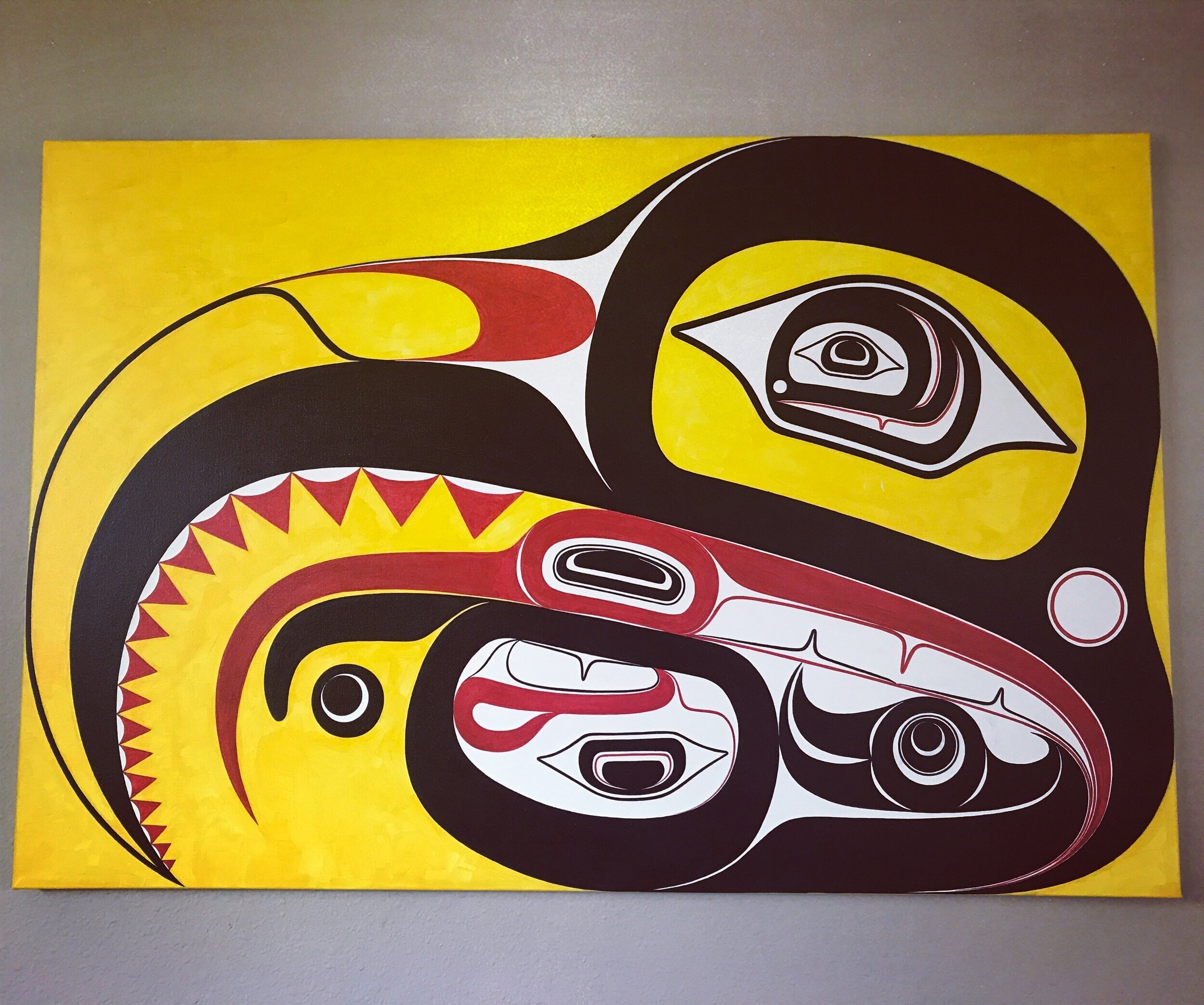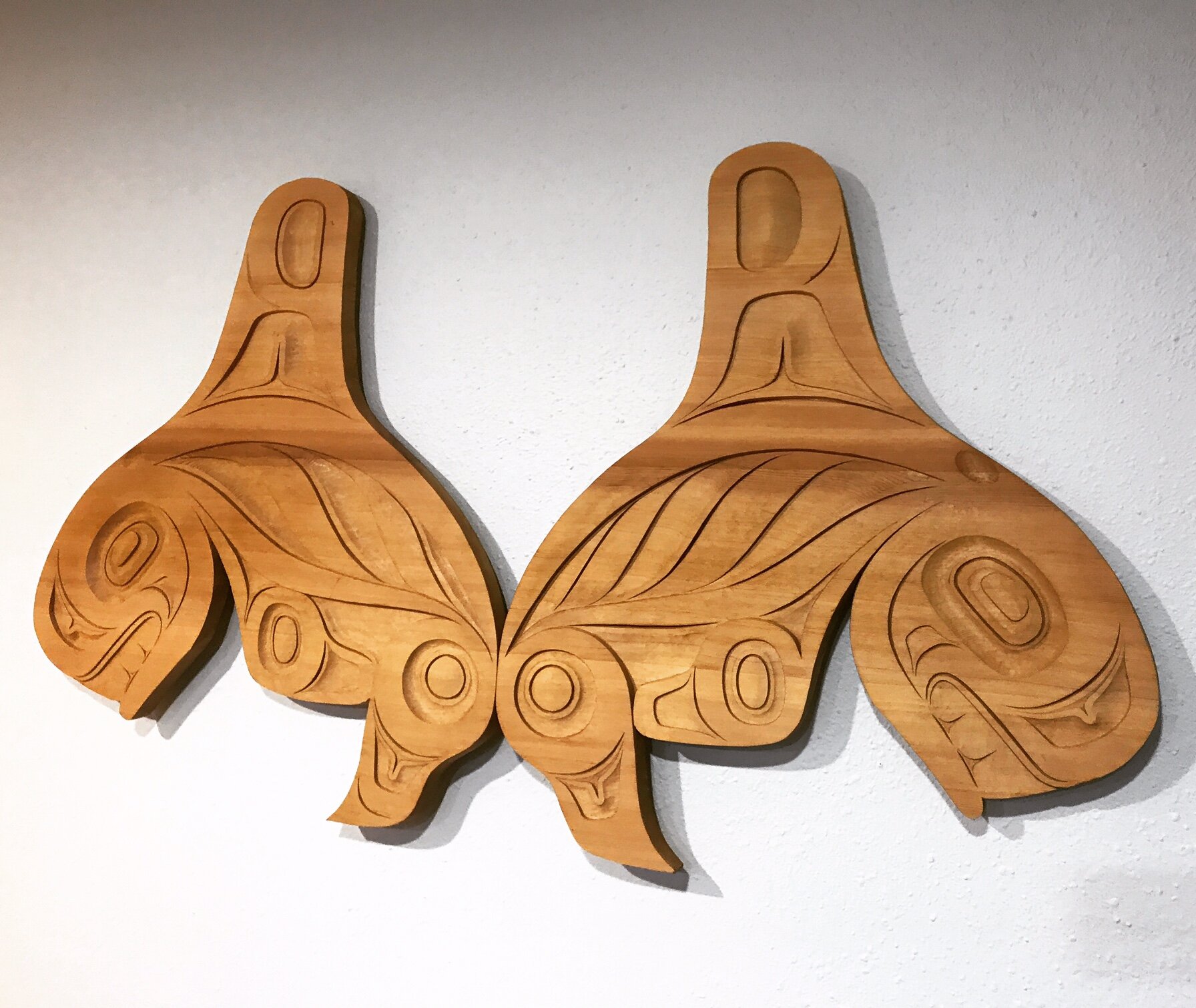‘Yaadachoon’
Aluminum
20’ 10” X 91” X 6’
(1/5)
Capable of enduring the most treacherous waters of the Northern Pacific Ocean to ensure our survival, canoes built and designed by Indigenous peoples of the Northwest Coast have been the mode of transportation for thousands of years. Creating these magnificent canoes has allowed us to participate in trade, attend sacred ceremonies, as well as harvest foods from up and down the Northwest Coast. In order to effectively and efficiently glide through the water, working together in unison is required to reach our destinations.These canoes are incredibly utilitarian, dynamic and loaded with aesthetic appeal.
‘Yaadachoon’ is an amalgamation of two divergent worlds juxtaposing the marginalized and muted ethos of the Tlingit; often considered to be legends or myths, with the Western constructs of governance that we use today. This canoe sculpture is a vessel of humanity, which highlights opposing sides by bisecting the canoe in half. This piece allows us to take a further look into the binary self governance structure of the Tlingit, the Eagle and Raven, and the civic duties to always care for and uphold your opposites. The body of the canoe is void, as it leaves a very sizable negative space that is indicative of political and social unrest of today. But also adheres to complex design principles of ‘Formline’ and using negative to formulate a positive space. May this be a reminder for us all, to implement the unfailing civic duties of Tlingit people, to uphold respect and acknowledge your opposites, ensuring that we will always be paddling in unison towards the betterment of humanity.
“The Strength That Resides In Us All"
Red Cedar, Acrylic, Horse Hair
44” X 30” X 20”
All too often, Tlingit (and all Indigenous) narratives are disregarded as legends or myths, not taking into account the thousands of years spent discerning humanity. From those thousands of years spent observing, came to fruition chronicles that were implemented to help navigate generations forward. One of which was the history of Dukt’ootl’ (Blackskin), he is our ‘Strongman’, that is frequently remembered for tearing a seal lion in half; what is often forgotten is the strength he enacted by overcoming the barrage of insults and mockery from his own people. Being an outcast could have easily overcome him with bitterness and low self esteem, but perhaps his greatest strength of all, was the mental fortitude to overcome the ridicule and convert into strength. Resistance comes in a plethora of forms, is omnipresent, and is Universal to humanity; the Ancient ones knew this and left behind a wonderful illustration of how we can use resistance to strengthen ourselves for any endeavor.
‘Exit to Enter?’
Red Cedar, Forton, Horse Hair, Italian Poplar
40’ X 6’ X 30”
For a milenia Tlingit ancestry has been roaming these great lands of the Northwest Coast, where they have always been listening, feeling, discerning, and being subjected to all that the natural world has to offer. So much so that they fostered a unique kinship with land and animals, depths that we can’t fully comprehend today. This connection is displayed by the tongues of the Eagle and Raven injecting into the consciousness of a bronzed ancestor, as our ancestors are the bedrock that we construct upon today. With an interconnection so strong that it requires all five senses and another dimension; we began to articulate this essence, as shown here by coming out of the mouth, manifesting itself into a great civilization, bolting into the Tlingit Villages of Southeast Alaska.
Now juxtapose that exit in a contrary direction, coming from Tlingit Aani, into this western world. That essence previously described, the Tlingit ethos, bombarded, pillaged, discarded, and dispatched to be assimilated. The Tlingit Spirit, vibrant, proud, dynamic and thriving; was shoved back in our childrens’ mouths with soap, punished for articulating the potent way in which we viewed the world. This severed the intergenerational teachings in our language. We were exported to boarding schools, severely maltreated, and colonial impositions further forcing our Tlingit disposition out of our consciousness. This is identified by the supernatural realms coming out of the mind of the ancestor, and back to the Eagle and Raven which are almost indistinguishable between the two, commodified, curated, and encased for all to see.
“Ravens Unwarranted Disclosure”
Acrylic on Red Cedar
42” X 18” X 21”
The evolution of the Transformation Mask had been working its way north, activated and personalized by the different Nations and Artists of the Northwest Coast. This wonderful technology and innovation was just on the fringe of Tlingit territory when the Colonial period began to eviscerate Southeast Alaska.
Leave it to Raven. The Provocateur. Constantly pushing our consciousness along.
As Indigenous peoples today, we must check all the boxes and play the part. Fit the fuzzy narratives of today, share our culture, but not the atrocities that our people had to endure. The optics are a must, as long as we look the part. The exterior of the mask is representative of that.
What about all the heaviness and afflictions that we choose not to talk about? The generations of trauma that we are still seeking to remedy today? The issues that have been swept under the rug and cause the shame that is represented by the interior mask looking down, unable to look straight ahead.
The inside of the Raven Mask is perhaps representative of some of the inner dialogue that we as Indigenous Peoples have with ourselves. One side depicts two faces, one clearly being a face representing this Western world which we reside, is upside down? The other face is inspired by a ‘primitive’ petroglyph found in Tlingit territory. The arrows and directions are tying the mouth and minds leaving one to perhaps get a glimpse of the convoluted and complex dialogue that perhaps is the impetus of our Indiginiety today.
The opposing side of the Raven Mask consists of the four generations of historical trauma. How is one to attempt to articulate all the mental battles that have existed for generations with Formline. The issues that most people can't or won't talk about. The heaviness. The anxieties. The depression. Amidst all of those afflictions, depicts a tribute of the generation that had to dance in sheets and cardboard headdresses, with designs far be it removed from the Masters of the past, but arguably, they were the most important generation, literally hanging on by threads.
“Fog Woman”
Aluminum
16’ X 40”
The story of Fog Woman is a wonderful illustration of the depth of understanding that our Ancient ones had for humanity. Despite all the hardship, deception, and abuse that Fog Woman had to endure from Raven, she did not allow it to define her. Regardless of her unenviable situation, she continued to focus her mind on her destination, a superior place, in every dimension. She would go and spend time visualizing and speak into existence the salmon that she eventually created. Today neuroscience acknowledges that we can literally change our physical body based off of the brain chemistry of our thoughts, perhaps that's how she transcended into 'Fog'. Time and again in Tlingit oratory, I've come across the importance and power of our minds, the ancient ones knew what neuroscience is discovering today and 'Fog Woman' is an exemplary example of that.
Raven Resists the Linear
36” Acrylic on Red Cedar
Embryonic Eagle
36” on Red Cedar
Ravens Portal
Side 1
14”x15”x19”
Ravens Portal
Side 2
14”x15”x19”
Ravens Portal
Side 3/4
14”x15”x19”
Thunderbird Panel
42” x 27.5” on Yellow Cedar
Eagle/Wolf Panel
36” on Red Cedar
Eagle Ascent
Red Cedar 72” x 18”
















